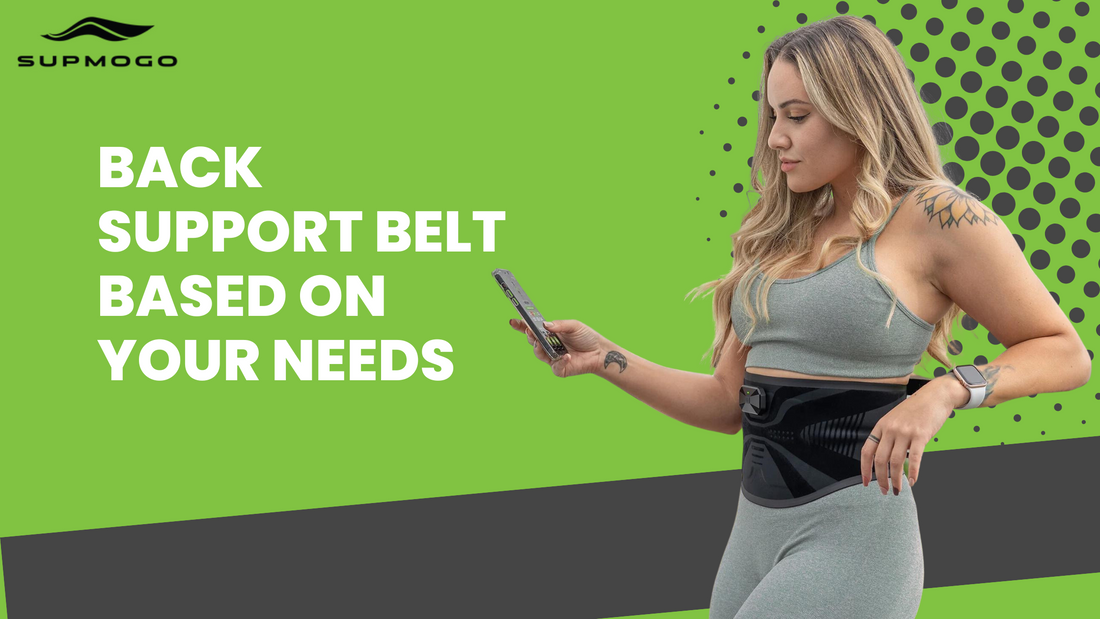Have you faced an injury or tried hard to keep your back balanced during the arduous heavy lifting of 150 kg dumbbells?
Your back requires additional support at any point in your life. Even in young adults, back and stability issues have been through the roof recently, especially after the pandemic. 1
Although many people harness medical and physical assistance to overcome back issues, it either takes time or doesn't give the expected outcomes. So, what should you do? Try using back support belts trusted by athletes and many doctors to treat injuries and augment the rehabilitation process.
After getting the ‘right back support belt’ according to your need, roaming confidently without any issues won't remain a tough nut to crack. But how can you find a good back support belt? This is what we will discuss in today’s reading.
In this article, you’ll learn:
Reasons You Might Need a Back Support Belt- Flexibility
- Materials
- Adjustment and Additional Features
- Technologies
- Digestion Problems
- Over-Dependence
- Loss of Muscle Strength
- Skin Issues
- Weaken Circulation
Reasons You Might Need a Back Support Belt
You can use a lumbar support belt to get the following benefits:
1. Posture Correction
Most people have damaged their posture while working on the computer for extended hours. This is where the back support belt offers a helping hand.
The rigid material of the belt aligns the back in a straight posture and decreases back pain.
2. For Balance and Mobility
Back support belts provide relief against instability. These also offer spinal support and restore the equilibrium of the lower back hence, help to improve balance and mobility.
3. Decrease Inflammation
The back support belt's warmth also helps stack off inflammation slowly. Research says warmth reduces inflammation by receding the affected area's extra fluid, toxins, or white blood cells. 3
4. Pain Relief
Back belts provide compression towards the back muscles, which rekindles circulation. It aids in combating swelling and appeases pain signals in the brain by unleashing endorphins.
5. For Muscle Recovery
Unrecovered tissues after injuries are prone to more injuries. Muscle lesions account for 10-50% of injuries, majorly for athletes. [4 ]
Back support belts lend a hand in supporting the back during injuries and let muscles recover without any hassle.
6. Enhance Metabolism
The warmth of the back belt can boost blood circulation, which induces a metabolism spurt. Increased metabolism helps in fat burn and healing and improves the transition of oxygen around the body.
7. For Support While Fighting Infections
Many doctors recommend back belts with antibiotic therapy for lower spine infections. The back belt inhibits infection stimulation and reduces inflammation in the back area to avoid further harm.
Factors to Look For While Choosing A Back Support Belt
Each back belt is created differently, so as you acknowledge your needs, you need to choose a back brace that aligns with your requirements.
Let's hope into the different features you should look for while getting this job done:
Flexibility
Back belts are made rigid, slightly flexible, or flexible according to the buyer's needs.
- Flexible belts help in lumbar support and enhance mobility. These back braces are the best support belt for work, sports, and strenuous activities requiring heavy lifting.
- Slightly flexible belts are usually made with nylon or leather to ensure slight movement and good support. These types of back belts are best for improving posture and stability.
- Rigid back belts are good for pain relief. Stiffness helps in injury recovery and back pain treatment by providing compression.
Materials
Back belts are made from different materials, and the commonly used materials include the following:
- Soft lining or heavy-duty Velcro is used for prolonged use without skin issues.
- Neoprene is used when stretching, flexible, comfortable, lightweight back belts are required.
- Nylon is used in back belts where it needs to be breathable.
- Leather is used for rigid back braces that are best for support purposes.
Adjustment and Additional Features
Back braces are developed with many features for secure adjustment and comfort levels. Stiffness and pressure are adjusted through various added features in belts.
- Adjustable straps are required in the orthopedic belt for back pain for females to stack up the compression.
- Moreover, wide back panels for orthopedic belts for back pain for males to cover the larger area of the male body.
- Reflective tape and lumbar pads are also used for unwavering comfort.
Technologies
Here are some of the most popular technologies used in back braces to elevate the healing process.
- Magnetic Therapy
- Vibration
- TENS
Side Effects of Lumbar Support Belt
Although the back support belt always plays a vital role in improving your back health, the saying goes, "Every good thing includes something detrimental." If a thing is used excessively or without caution, it may add fuel to the fire instead of blowing.
Here are some possible side effects of lumbar support belts to be aware of:
- Digestion Problems
Extensive pressure on the gut area and diaphragm after using a tightened back belt can provoke digestive issues such as acid reflux, indigestion, bloating, and stomach ache.
- Over-Dependence
At some point, people get overly dependent on back belts and lose their ability to support their back and mobility. This physiological dependence can harm the natural strength of the back.
- Loss of Muscle Strength
After long-term usage of the back support belt, muscles may lose the strength to support the backbone. As the lumbar belt restricts the entire movement, it will weaken the muscles to work as they should.
- Skin Issues
Most people complain of skin rashes, bruises, and irritations after using their back belts for extended periods. People prone to skin diseases and allergies are more likely to have skin sensitivity after using back belts.
- Weaken Circulation
Tightened back belts may also compress nerves, and blood circulation taper off in the lumbar area and the whole lower body. It may cause enormous harm, numbing the lower body, and may develop blood clots.
Conclusion
Sloughing shoulders and strained muscles while heavy lifting amidst many conditions is a common cause that worries many people. While back braces are not the actual treatment for any back issue, they can significantly help speed up your recovery and fitness journey.
SUPMOGO RecoveryFlex system belt is the jack of all trades that won’t deceive you in your fitness route. Striking movement improvement during exhausting activities and a healing process at your fingertips- you will regain your independence and health in no time.
Check our website right now for more information!
Endnotes
- Papalia, G. F., Petrucci, G., Russo, F., Ambrosio, L., Vadalà, G., Iavicoli, S., ... & Denaro, V. (2022). COVID-19 pandemic increases the impact of low back pain: a systematic review and metanalysis. International Journal of Environmental Research and Public Health, 19(8), 4599.
- Saragiotto, B. T., Maher, C. G., New, C. H., Catley, M., Hancock, M. J., Cook, C. E., & Hodges, P. W. (2018). Clinimetric testing of the lumbar spine instability questionnaire. journal of orthopaedic & sports physical therapy, 48(12), 915-922.
- Yutan, W. A. N. G., Hongmei, L. U., Sijun, L. I., Zhang, Y., Fanghong, Y. A. N., Huang, Y., ... & Yuxia, M. A. (2022). Effect of cold and heat therapies on pain relief in patients with delayed onset muscle soreness: A network meta-analysis. Journal of Rehabilitation Medicine, 54.
- Delos, D., Maak, T. G., & Rodeo, S. A. (2013). Muscle injuries in athletes: enhancing recovery through scientific understanding and novel therapies. Sports Health, 5(4), 346-352.
- Henry, S. L., Concannon, M. J., & Yee, G. J. (2008). The effect of magnetic fields on wound healing: experimental study and review of the literature. Eplasty, 8.

